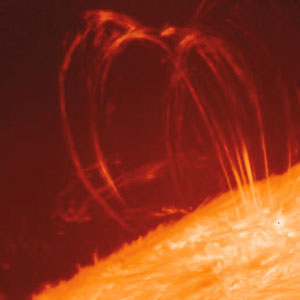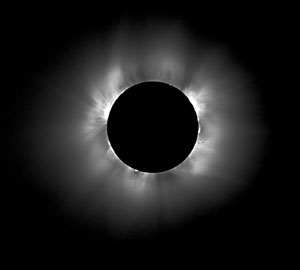The Sun may be the centre of our world, but it is not a typical star. At a special meeting, arranged by l’Observatoire de Paris at the Moët et Chandon manor at Epernay for the total solar eclipse of 11 August 1999, CERN physicist Douglas R O Morrison shed light on the Sun’s past, present and future.

Stars are formed from huge masses of gas and dust. From fluctuations, a centre forms and then, under gravity, more and more matter gradually accumulates until a core is formed, which attracts more gas and dust. This core a protostar will get hotter. Under the effect of gravity, the protostar will contract and, if the core is big enough, nuclear reactions (fusion) will cause it to ignite. Thus a star is born.
Multiple star systems
This is how I used to imagine that stars were formed. When I looked up at the sky, I saw our Sun as a solitary star and the sky full of single stars. The idea of binary star systems with two stars rotating round one another seemed quite unnecessary. It therefore came as a shock when I learned that only 15% of stars are single, while 65% are in binaries and the remaining 20% are in clusters of three or more. This seemed contrary to the concept of a big cloud of gas and dust condensing.
For me, the explanation came in an early photograph from the Hubble Space Telescope (figure 1). It showed a star-forming region of Freudian complexity that explains the birth of multiple star systems. We are fortunate that our star is a solitary one.
When the Sun was born, some 4600 million years ago, its gas was composed of 72% hydrogen, 24% helium and the remainder was a variety of elements, which had been formed almost entirely in supernova explosions and then blown out into space. The mass of the Sun is 2 x 1027 tons, or 2000 million million million million tons.
When a star is formed, its contraction makes it spin faster (like an ice skater pulling in his or her arms). Such a T Tauri star is distinctively bright for its mass. However, as it spins, it throws off mass, losing some 2000 million million million tons every year. It soon slows down, and today our Sun is losing some 20 million million tons per year (or 700 000 tons per second) as solar wind.
Solar flares
This stellar erosion can be seen during a total solar eclipse. The radius of the Sun is about 700 000 km, so the easily visible part of the solar wind, seen during an eclipse, extends out from the surface by more than a million kilometres. Occasionally a large flare will occur. An example of this is shown in figure 2.

The fate of a protostar core depends on its mass. If the protostar weighs less than 0.08 solar masses, the temperature of the core is not high enough to initiate nuclear fusion reactions and the protostar remains as an inert Brown Dwarf.
If the protostar weighs more than 8 solar masses, something new happens: the density of the core becomes so great that the inner 100 km or so of the star collapses within a few milliseconds, and the resulting ionized plasma is compressed into neutrons. Such a neutron star has an enormous density about 100 million tons/cm3.
The sudden collapse of the core generates a shock wave that compresses the neutron star even further. This rebounds, and the outward-moving shock wave then hits the remainder of the star, which, meanwhile, has hardly moved. The blast blows the shell apart and ignites it to produce the visible supernova.
If the star so formed is still massive about 20-30 solar masses then the neutron star can collapse further to give a black hole.

The basic reaction that initiates star formation is the fusion of two hydrogen nuclei (protons) to form deuterium, followed by the deuterium rapidly combining with another hydrogen nucleus to give helium-3. This happens very quickly the deuterium only exists for a second before fusing with a proton. One could say that the deuterium acts as a catalyst, which converts three nuclei of hydrogen into helium-3. The helium-3 is then converted into a stable helium-4 nucleus via several routes.
Helium-4 is very stable and is generally the end of the chain. To go further, an unusual fusion reaction needs to take place between three helium-4 nuclei to give carbon-12. This can further react to give nitrogen and oxygen. This is called the CNO cycle. The next element, fluorine, can then be formed in the NOF cycle.

The Sun, which is essentially a plasma with no rigid structure, is fuelled mainly by hydrogen in its core, which is at a temperature of 15 million degrees centigrade. Its density decreases rapidly with distance from the core, where it is about 150 g/cm3. At the surface, the density is only a millionth of a gram per cubic centimetre and the temperature is about 5500 °C.
Bright future
As the Sun continues to burn, the temperature will rise and the core will contract, which raises the temperature even higher and makes the envelope expand. Eventually the Sun will become a Red Giant, at which point most of the hydrogen in the core is burned.
Then the core will contract further and become steadily hotter and hotter until it reaches a hundred million degrees centigrade. At this point the helium-4 will ignite and carbon-12 will be formed in a thermonuclear explosion. For the following 100 million years, the star will continue to be very bright.
The carbon can provide extra nuclei of helium-4 to generate oxygen-16 and neon-20, etc (the CNO and NOF cycles will not occur because the necessary hydrogen has already been consumed). Next, the carbon and oxygen will burn, but the thermonuclear furnace will eventually cut out and the core will become inert.
However, outside the core, the remaining hydrogen and helium gas will continue to burn for some time. This will drive off much of the gas and eventually the star will become a White Dwarf with a remnant mass of about half that of the Sun. This hot star will be visible for billions of years, but will eventually cool and become an invisible Black Dwarf.
When our Sun becomes a Red Giant, its expansion will first swallow Mercury (58 million kilometres away), absorb Venus (108 million kilometres away), engulf the Earth (150 million kilometres away) and finally approach Mars (228 million kilometres away).
Fortunately for us this fate is about 5000 million years away. The Sun is a vigorous adult star that still has a brilliant future.





